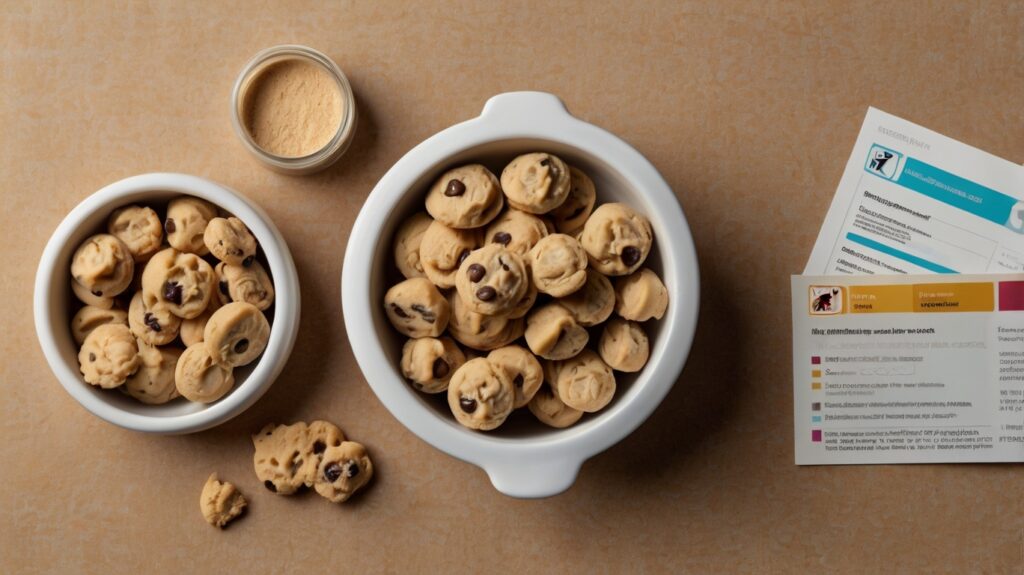Table of Contents
What Makes Cookie Dough Irresistible?
What makes cookie dough so irresistible? This beloved treat is enjoyed by many, both in its raw form and when baked into delicious cookies. The popularity of cookie dough stems from its versatility, ease of preparation, and the endless possibilities for variations and add-ins. In this article, we’ll explore what makes cookie dough, the key ingredients involved, and how to make it safe to eat and enjoy.
What Makes Cookie Dough: Basic Ingredients

The foundation of any good cookie dough is its ingredients. Understanding the role each component plays is essential to mastering the art of making perfect cookie dough.
- Flour: All-purpose flour is typically used to give the dough its structure. Flour acts as the base and provides the necessary gluten to hold the dough together. For those with dietary restrictions, gluten-free flours can also be used.
- Sugar: A combination of brown sugar and white sugar is often used in cookie dough. Brown sugar adds a molasses-like richness and chewiness, while white sugar contributes to the sweetness and crispiness of the final product.
- Fat: Butter is the most common fat used in cookie dough, giving it a rich flavor and smooth texture. However, margarine or other fat substitutes can be used as a dairy-free alternative. To learn more about the specifics of how cookie dough is made, you can check out this guide.
- Eggs: Eggs serve multiple purposes: they help bind the ingredients together, add moisture, and aid in the leavening process, which makes the cookies light and airy. In edible cookie dough, where raw consumption is intended, eggs are often omitted or replaced with pasteurized egg products to avoid the risk of salmonella.
The Science Behind What Makes Cookie Dough
Cookie dough is more than just a mix of ingredients; it’s a result of precise chemical reactions that occur during the mixing and baking processes. Understanding these reactions helps to achieve the desired texture and flavor.
- Creaming Method: This method involves beating the butter and sugar together, and incorporating air into the mixture. This step is crucial because it contributes to the texture and structure of the dough. The air pockets created during this process help the cookies rise and become light and fluffy when baked.
- Mixing Process: Overmixing can lead to tough cookies, as it activates too much gluten. On the other hand, undermixing may result in unevenly distributed ingredients. The key is to mix until just combined to avoid these issues.
- Chemical Reactions: The Maillard reaction and caramelization of sugars are vital in developing the flavor and color of cookies. The Maillard reaction occurs when proteins and sugars interact at high temperatures, creating complex flavors and a golden-brown color. For a deeper understanding of these chemical reactions, you can explore the science behind cookies.
How to Make Cookie Dough: A Step-by-Step Guide
Making cookie dough is a straightforward process, but there are some key steps and tips to ensure success:

- Combine Dry Ingredients: Start by mixing the flour, baking soda, and salt in a bowl. This ensures that the leavening agents are evenly distributed throughout the dough.
- Cream Butter and Sugar: In a separate bowl, beat the butter and sugars together until the mixture is light and fluffy. This step is crucial for incorporating air, which helps in achieving a good texture.
- Add Eggs and Flavorings: Mix in the eggs, one at a time, followed by vanilla extract. These ingredients add moisture and flavor.
- Mix in Dry Ingredients: Gradually add the dry ingredients to the wet mixture, stirring until just combined. Overmixing can lead to tough cookies, so be cautious.
- Add-Ins: Stir in any additional ingredients like chocolate chips, nuts, or dried fruit. These add texture and flavor to the cookie dough.
Edible Cookie Dough: Safety and Recipes
Traditional cookie dough is not safe to eat raw due to the presence of raw eggs and uncooked flour, which can harbor bacteria like salmonella and E. coli. To make cookie dough safe to eat:
- Omit Eggs: Use pasteurized eggs or egg substitutes if raw consumption is intended.
- Heat-Treat Flour: Heat the flour to kill any potential bacteria. This can be done by spreading the flour on a baking sheet and baking it at 350°F (175°C) for about 5 minutes.
For a variety of safe-to-eat cookie dough recipes, you can check out these edible cookie dough recipes.
Different Types of Cookie Dough and Their Uses
There are numerous types of cookie dough, each suited to different kinds of cookies and desserts:

- Safe cookie dough
- Classic Chocolate Chip Cookie Dough: This is the most common type of cookie dough, loved for its simplicity and the perfect balance of sweetness and chocolatey goodness.
- Sugar Cookie Dough: This dough is ideal for shaped and decorated cookies. It’s easy to roll out and holds its shape well when baked.
- Specialty Doughs: There are various options for those with dietary restrictions or preferences, including vegan and gluten-free cookie doughs. These are made by substituting ingredients like eggs and flour to meet specific needs.
Creative Uses for Cookie Dough
Cookie dough isn’t just for making cookies. It can be used creatively in various desserts:
- In Ice Cream: Cookie dough ice cream is a popular treat where chunks of dough are mixed into vanilla ice cream, providing a delightful contrast of textures.
- Baked Goods and Desserts: Use cookie dough as a layer in brownies or as a filling in cakes for a unique twist.
- As a Standalone Treat: Edible cookie dough can be enjoyed straight from the bowl, making it a favorite snack for many.
FAQs: Common Questions About What Makes Cookie Dough

Cookie dough ingredients
- What is the difference between cookie dough and cookies?
Cookie dough is the uncooked mixture of ingredients, while cookies are the baked product. Dough is often enjoyed raw or used to make cookies by baking. - Can cookie dough be frozen?
Yes, cookie dough can be frozen. This allows you to prepare dough in advance and bake fresh cookies at a later time. - What makes cookie dough safe to eat?
Edible cookie dough omits raw eggs and uses heat-treated flour to eliminate the risk of bacterial contamination.
Conclusion
What makes cookie dough irresistible is its perfect combination of flavor, texture, and versatility. By understanding the key ingredients and the science behind it, anyone can create delicious and safe-to-eat cookie dough at home. Whether you’re making classic chocolate chip cookies, experimenting with new flavors, or simply indulging in a spoonful of raw dough, cookie dough remains a cherished favorite among people of all ages.




